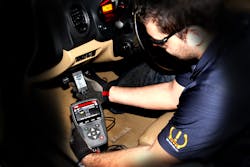All light duty passenger vehicles manufactured after September 2007 have been mandated by the government to be equipped with Tire Pressure Monitoring System (TPMS). This has improved on-road safety and fuel economy says Brandon Montney, regional sales manager for ATEQ TPMS Tools LC.
The major issue with TPMS sensors is that the sensor's battery, which enables it to communicate with the vechicle control module, has a shelf-life of between seven and 10 years, it is not replaceable without causing serious damage to the sensor itself and each car manufacturer has its own "Sensor Matching Process" or "Sensor Reset Procedure," adds Montney.
Complete TPMS service includes the ability to diagnose, test, repair and reprogram vehicles with these systems, so for aftermarket shops that provide TPMS service for multiple makes of vehicles, this presents a challenge. To combat this, these shops need access to proper TPMS diagnostic equipment capable of servicing all makes and models. This is where you, as a tool distributor, come in.
Types of TPMS tools
The market for TPMS tools and replacement products is continually evolving, says Scot Holloway, CEO for Bartec USA. "In the beginning, TPMS meant that tire shops that never had diagnostic equipment, now had to invest in greater technology and training. Now, in addition to higher technology equipment, today’s tire shops need to understand the ever growing differences between replacement sensor types and the way they function. Initially sensor replacement was limited to part-for-part or direct replacement parts offered by the OE sensor manufacturers." He adds that now sensors come in many forms including: programmable, clonable, multi-application and configuration offerings, by a multitude of different suppliers.
Debo Sadare, product manager for OTC, says that as distributors, you should be aware of the types of replacement TPMS sensors available and if the tool manufacturer's tool options universally works with all TPMS sensors. Similar to a diagnostics tool, a Tire Pressure Reset (TPR) tool must be compatible with all vehicles and sensors to work effectively in a shop. "Other options to look for are Bluetooth connectivity, whether or not it pairs with a scan tool and ease of use/functionality. Standalone tools provide additional features beyond Tire Pressure Reset (TPR) Tools including relearn/reset functionality to ensure value for the shop and technician."
"Some vehicle manufacturers have built-in reset and relearn procedures while others use an indirect TPMS system and may require the use of a Tire Pressure Reset (TPR) Tool paired with a scan tool for sensor reprogramming. Another option is to use an all-in-one TPMS tool with sensor activation and relearn capabilities," adds Sadare. "Having a TPMS activation tool with relearn capabilities can save technicians time and hassle after sensor replacement, enabling them to quickly reset sensors and IDs to a vehicle."
Harlan Siegel, vice president of Launch Tech USA says there are two tools needed for everyday TPMS diagnostic service. "One is an affordable handheld TPMS tool that can directly read the data from the sensor, act as an activation tool and have sensor programming capability for many applications. The other is a current scan tool that can get into the module for codes, data and registration functions for those vehicles that require a OBD-II communication. In many shops it might make sense to have both that work together when needed, or the option for a dedicated all-in-one tool."
In the know
As a distributor looking to uncover a TPMS tool sales opportunity it's important to ask questions, including what the customer currently uses for TPMS service, says Launch Tech's Siegel.
Responses can include that the customer doesn’t currently have a TPMS tool, or he may be looking to purchase a new or upgraded tool that provides additional functionality.
"Whatever that response is, it's a sale opportunity for that distributor. He just needs to ask the question and he also needs to have one on the truck or in his store." Siegel further stresses the importance for distributors to come prepared. "Let's say (the technician's) existing tool broke, or he has an urgent need for a TPMS tool and that tool distributor stops there that day. Well, if he has it on the truck, he probably has a sale. If not, in an urgent situation, that shop owner may buy it from the next distributor that stops or from another source that can deliver it."
Michael Flink, national sales manager for Autel, says it's important to know if the shop you service works on tires and whether or not it has a tire machine. "If they don't, the amount of TPMS work they do will be limited." He adds, "Make sure the customer understands while a scan tool may access the TPMS controller in a car, a separate TPMS activation tool is still required to service TPMS."
Here's a list of questions you can ask customers to gauge their interest/need in purchasing TPMS tools:
- What is the average age of the vehicles you see in your shop?
- Do your customers typically fix every issue that arises on their vehicles or simply issues that relate directly to powertrain and major operational issues? (Think engine, transmission, brakes, heat)
- How many tires are you servicing and selling?
- How many of those have TPMS?
- Is your shop currently seeing vehicles with TPMS lights on or performing TPMS replacement?
- Did you know that TPMS sensors have wear items and need to be serviced?
- If you are performing TPMS sensor replacement, how long is the average job taking?
- Is your team replacing one sensor at a time or all 4/5 depending on whether or not the spare has been outfitted with a sensor?
- Are you charging for TPMS service?
Choose a tool that stands out
The list of questions above can help determine what type of tool a shop or technician will need, but it's important to stock tools that stand out in one way or another.
"TPMS service is often complex and confusing and having a support mechanism, like a TPMS tech support hotline, is critical," says Bartec USA's Holloway. "Choose manufacture partners based on their knowledge and ability to make you, the distributor, look good.
"TPMS is based in radio frequency technology, and high-end vehicle diagnostics. Partnering with the low cost, package deals might help you sell more at a lower margin, but will they be there when your customer needs them?" adds Holloway.
Autel's Flink says that how often and easily a tool updates, cost of updates, and relearn or procedure information in the tool are also important functions to look for. "Most good tools have some procedure reference or help menus. The key is how often are these updated, ease of updates and do they include procedures for systems that don't require a tool."
He also says, "In the area of programmable sensors a stumbling block is to 'copy' or 'clone' an old sensor to a new one the tool has to read the old one first. Trouble is, you are replacing it because it's bad, so often, you can't read it. Autel has added an option to copy by OBD-II, allowing the technician to use the ID in the car's controller to program the new sensor."
"Kits with a full function tool and a sample of sensors are a great idea for starting a shop on its way."
Launch Tech's Siegel says that in terms of the diagnostic process, TPMS tools have become much more affordable than in the past, and that some scan tool software has improved to the point that it will tell technicians why the TPMS light is on. "Not only for the repair and replacement, but for sensor reprogramming or registration, as required by some vehicles."
TPMS relearns for tire rotation may be necessary for some vehicle makes. Some vehicles "know" which tire is where and; therefore, relay that information to the driver when the dashboard light goes on. If a technician performs a rotation without a relearn, the TPMS sensor will identify the incorrect tire to the driver.
Display and demonstrate
The best way to showcase a TPMS tool is to allow the technician to complete a hands-on demonstration, says OTC's Sadare. "A live demonstration is always the most effective way to understand the tools full functionality and overall user experience. With a live demonstration, the technician or shop owner is also in a better position to determine what kind of TPMS tool is most suitable for their specific work environment."
Always have a demo tool and replacement sensors handy on the truck, says Bartec USA's Holloway. "The best way to sell TPMS service is by demonstration. If you can arrive on sight with the parts, tools and the ability to repair a TPMS, that often times is an easy sell."
Autel's Flink agrees, "A tool and sensor kit, when offered, make a great display and can entice the customer with the ability to recoup his investment once the sensors are sold." He says that distributors can get an old TPMS sensor and, knowing which vehicle it comes from, use it to demonstrate the tools on their trucks.
Speaking on behalf of the Launch TPMS tool, Siegel agrees. He says that distributors should obtain an aftermarket sensor to keep on the truck. Using the tool, the distributor can easily demonstrate how the particular tool reads the sensor at a minimal investment to the distributor. "He can show how it reads the pressure, the frequency, the temperature and battery condition, he can read that from any popular OE or aftermarket replacement sensor that can be purchased from any parts supplier. It's really simple, but because of its simplicity, I’d have one of these tools on the truck and let the guys use it in the shop. Having an intuitive, user-friendly tool is paramount for that."
Siegel adds that there is a buyer beware component that distributors and technicians alike, should be aware of for TPMS tools. "There are companies that are in the sensor replacement market but also offer a TPMS tool. Some of these tools might not program all popular aftermarket or OE sensors. It’s important that when an investment is made, it's a for a universal tool, and it’s not tied to a specific branded aftermarket sensor, so the shop is prepared for whatever shows up in the shop."


